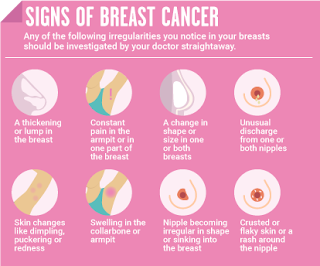BREAST CANCER
Introduction to breast cancer,signs and symptoms, risk factors, drugs,pathology,prevention, etc...Breast cancer is cancer that develops from breast tissue.
Signs of breast cancer may include a lump in the breast, a change in breast shape, dimpling of the skin, fluid coming from the nipple, a newly inverted nipple, or a red or scaly patch of skin.
In those with distant spread of the disease, there may be bone pain, swollen lymph nodes, shortness of breath or yellow skin.
RISK FACTORS of BREAST CANCER
= Risk factors for developing breast cancer include being female,
* Obesity lack of physical exercise.
* Drinking alcohol.
* Hormone replacement therapy during menopause.
* Ionizing radiation, early age at first menstuation, having children late or not at all.
* Older age, prior history of breast cancer, and family history.
* About 5–10% of cases are due to genes inherited from a person's parents,including BRCA1 BRCA2.
* Others.Breast cancer most commonly develops in cells from the lining of milk ducts and the lobules that supply the ducts with milk.
SIGNS AND SYMPTOMS OF BREAST CANCER
* The first noticeable symptom of breast cancer is typically a lump that feels different from the rest of the breast tissue.
* Lumps found in lymph nodes located in the armpits can also indicate breast cancer.
* Indications of breast cancer other than a lump may include thickening different from the other breast tissue.
* One breast becoming larger or lower.
* A nipple changing position or shape or becoming inverted.
* Skin puckering or dimpling.
* A rash on or around a nipple, discharge from nipple, constant pain in part of the breast or armpit.
* And swelling beneath the armpit or around the collarbone Pain ("mastodynia") is an unreliable tool in determining the presence or absence of breast cancer, but may be indicative of other breast health issues.
INFLAMMATORY BREAST CANCER SYMPTOMS
* Inflammatory breast cancer is a particular type of breast cancer which can pose a substantial diagnostic challenge.
# Symptoms may resemble a breast inflammation.
And may include itching.
*Pain.
*Swelling.
*Nipple inversion.
*Warmth and redness throughout the breast as well as an orange-peel texture to the skin referred to as peau d'orange.
# As inflammatory breast cancer does not present as a lump there can sometimes be a delay in diagnosis.
Paget's disease Symptoms
This syndrome presents as skin changes resembling eczema, such as redness, discoloration, or mild flaking of the nipple skin.
Symptoms may include tingling, itching, increased sensitivity, burning, and pain. There may also be discharge from the nipple.
Approximately half of women diagnosed with Paget's disease of the breast also have a lump in the breast.
Occasionally, breast cancer presents as metastatic disease(Symptoms)
* Unexplained weight loss can occasionally signal breast cancer, as can symptoms of fevers or chills. Bone or joint pains can sometimes be manifestations of metastatic breast cancer, as can jaundice or neurological symptoms.
* Most symptoms of breast disorders, including most lumps, do not turn out to represent underlying breast cancer.
PATHOPHYSIOLOGY
# Mutations that can lead to breast cancer have been experimentally linked to estrogen exposure.
* Abnormal growth factor signaling in the interaction between stromal cells and epithelial cells can facilitate malignant cell growth.
* In breast adipose tissue, overexpression of leptin leads to increased cell proliferation and cancer.
RISK FACTORS
* Drinking alcoholic beverages even at relatively low (one to three drinks per week) and moderate levels.
* Dietary factors which may increase risk include a high-fat diet and obesity-related high cholesterol levels
* Dietary iodine deficiency may also play a role
* Evidence for fiber is unclear
* Other risk factors include radiation and shift-work
Genetic susceptibility
* Genetics is believed to be the primary cause of 5–10% of all cases.
* Women whose mother was diagnosed before 50 have an increased risk of 1.7%
* whose mother was diagnosed at age 50 or after has an increased risk of 1.4. In those with zero, one or two affected relatives, the risk of breast cancer before the age of 80 is 7.8%
PREVENTION
* Women can reduce their risk of breast cancer by
maintaining a healthy weight
* Reducing alcohol use
* Increasing physical activity, and breast-feeding. These modifications might prevent 38% of breast cancer
* Removal of both breasts before any cancer has been diagnosed or any suspicious lump or other lesion has appeared
DRUG USED
* The selective estrogen receptor modulators(such as tamoxifen) reduce the risk of breast cancer but increase the risk of thromboembolism and endometrial cancer.










No comments:
Post a Comment